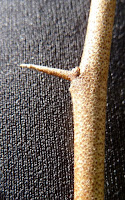 This weekend scoutmaster Chris Hill brought Troop 200 from Nixa, MO to Bull Mills for two days of camping and hiking. If you want to see hard to find species, there is no better way than to set loose a bunch of young eyes with no preconceptions. They look closely at everything!
This weekend scoutmaster Chris Hill brought Troop 200 from Nixa, MO to Bull Mills for two days of camping and hiking. If you want to see hard to find species, there is no better way than to set loose a bunch of young eyes with no preconceptions. They look closely at everything! |
| Mud puppy on upper Bull Creek |
 |
| Wikimedia |
It is unusual to find these in a small shallow stream like upper Bull Creek. This section was bone dry in both directions for months during last years drought. It is also unusual for them to come out during the day unless the water is murky. The water here was crystal clear and only 4 " deep.
Mudpuppies live on the bottom, hiding under rocks and vegetation, usually feeding only at night. The structure of their mouth allows them to suck in prey, then grasp it with two rows of teeth. They eat virtually anything they can get between their jaws, and frequently end up taking a fishing lure. Although a fishing myth says their skin is toxic to humans. It is toxic to animals eating them raw, but they can be handled safely to remove the hook, so release them back in the water.
As sexually mature adults they measure 8-13". Their average lifespan in the wild is eleven years, so this one is going to have a real story for its grandkids, about the time the boy scouts came to Bull Creek.
A "wolf spider" on a log got a lot of attention from the boys. There is a tendancy to call any large spider a wolf spider. They are members of the Lycosidae family, encompassing over 2,200 species with 230 found north of Mexico. They have good vision and a delicate sense of touch which makes them effective hunters.
One of their most endearing features is the maternal instincts of the female. They carry their sac of eggs on the spinnerets (silk glands at the end of the abdomen). If they lose the sac, they will sometimes substitute bits of shells or paper to make up for the loss.
Once the spiderlings hatch, they climb on the female's back, for protection. If they fall off, they will climb up her leg to get back on board. She tolerates the burden, only brushing them away from her eyes.
Spider identification is difficult, requiring careful inspection of the body and especially the head and palps. Even classifying a spider as a wolf spider can be tricky, as I demonstrated with a mistaken identification I made on a blog on the nursery web spider. It carries its egg sack in its chelicerae (jaws) rather than on the abdomen like the wolf spider.
 After the nature merit badge hike, Barb and I finished with a skull session, discussing the dental characteristics of herbivores, carnivores and omnivores (which we discovered includes scouts).
After the nature merit badge hike, Barb and I finished with a skull session, discussing the dental characteristics of herbivores, carnivores and omnivores (which we discovered includes scouts).Amphibiaweb.org has a lot more detailed information on mudpuppies.








































